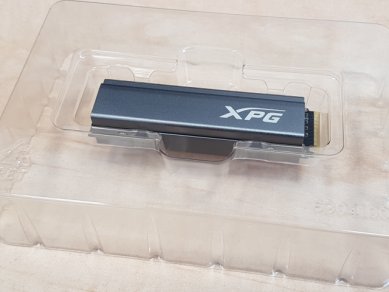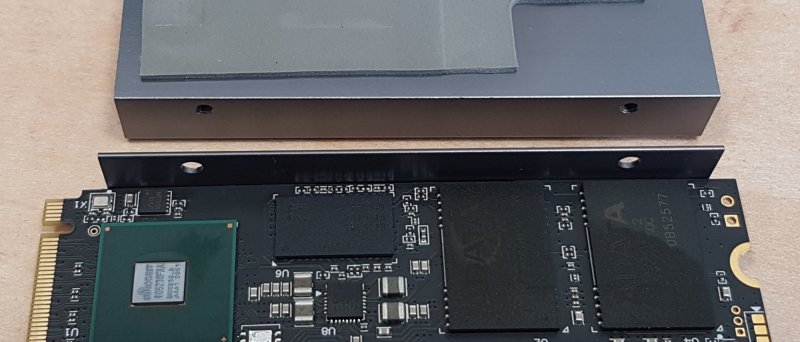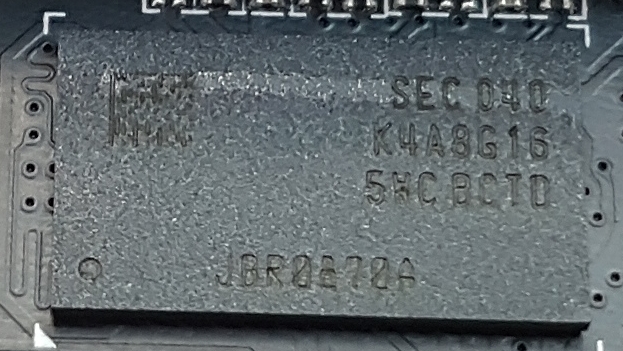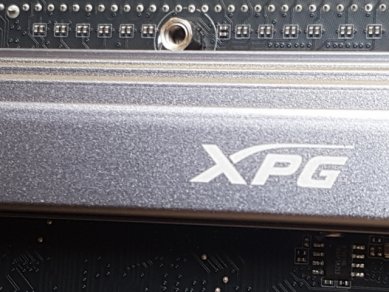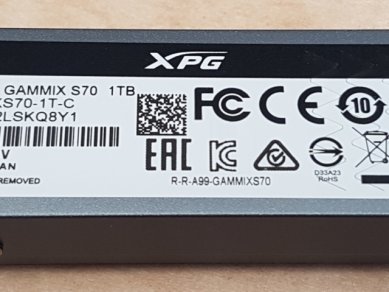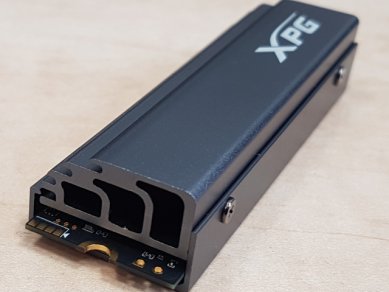ADATA sells tested SSDs for 4299 CZK with VAT (price varies slightly in some e-shops), which puts the drive in direct competition with the WD Black SN750 or Seagate FireCuda 510, however, both of these drives are PCIe Gen3. For example, the affordable PCIe Gen4 drive is the Corsair Force MP600 Core 1TB, but it is slower on paper and offers only 225 TBW. The nearest powerful PCIe Gen4 drive is the Gigabyte AORUS Gen4 1TB SSD, which sells for some 4800 CZK, is faster on paper, but without a heatsink.
The ADATA XPG GAMMIX S70 1TB is again in an interesting position, as it is cheaper than some of the competitors and offers something extra, specifically a massive aluminum heatsink. The SSD is produced in 1TB and 2TB variants, while the 1TB variant has a five-year warranty and can handle 740 TB of transcripts, while the 2TB version can handle up to 1480 TB of transcripts.
The SSD itself has a minimalist package, in which we can find more or less everything we need, ie the SSD itself, the manual and other software can be easily downloaded from the Internet.
On the positive side, the heatsink can be partially dismantled, a solid piece of aluminum holding two screws in place. Out of curiosity, I disassembled the heatsink because I wanted to use it on the used controller and chips. After unfolding, I was surprised by the shape of the thermal pad, however, NAND chips typically do not need much cooling, however, the cutout is somewhat strange.
On the top of the PCB we can see the brand new Innogrit Rainier IG5236 controller, this controller is connected to the system via four PCIe Gen4 lines, supports MLC, TLC and QLC NAND memories and offers a total of eight channels for NAND. The controller also supports ECC caching and has a 32-bit bus for DRAM cache connections. The controller also supports the NVMe 1.4 standard and a total NAND capacity of up to 8TB. Next to the controller we find the DRAM cache, it is a DDR4 module from Samsung with a capacity of 1GB and the throughput can be 2667 MT / s, provided that it supports the controller in the controller, which I have no way to verify.
It is a bit annoying that ADATA decided to stick the lower part of the heatsink to the SSD instead of using a standard heat-conducting pad. This is the main problem with this SSD, the heatsink is too wide and the SSD does not fit all motherboards. I was considering removing the SSD PCB from the heatsink somehow, but it would probably require some great heating, a break-off knife or something like that, so I dropped the idea of disassembly because I didn’t want to damage the SSD.
However, I came across a real problem with mounting the SSD on the motherboard, I can’t fit the SSD to the primary slot connected to the CPU, as the AMD X570 chipset heatsink interferes with it. So I thought of putting the SSD in the second slot, but there it collided with the bottom metal backplate of the motherboard. In the end, I temporarily removed the backplate, but this is not the optimal solution, as the VRM for the CPU thus comes with extra cooling from below the PCB.
The main problem will be compatibility, you can forget about mounting in a laptop straight away, in desktops the SSD can be used only if there is enough space around the M.2 slot. I see this as the biggest problem with SSDs, but it would be enough not to glue the SSD itself to the bottom plate of the heatsink and use only a heat-conducting pad, similar to what Gigabyte does with its SSDs.

The SSD allegedly uses NAND chips from Micron and these are 96-layer 3D TLC chips, but I don’t know exactly which ones, as they are renamed ADATA. There is also an SLC cache, but I do not know its size, because it is dynamic.
In terms of performance, ADATA claims that the SSD can read up to 7400 MB / s sequentially and write up to 5500 MB / s sequentially in terms of transcripts, listing 740 TBW for the 1TB version, which I consider sufficient given the capacity and price . In addition, the warranty is five years, provided that we do not write over 740 TB of data.
ADATA offers the ADATA SSD ToolBox program for its SSDs, in which we can perform actions such as firmware upgrades, find out the health of the SSD, Secure Erase and so on. In my case, the “Check Update” option of the firmware did not work, only the ERROR warning window popped up.
Test set
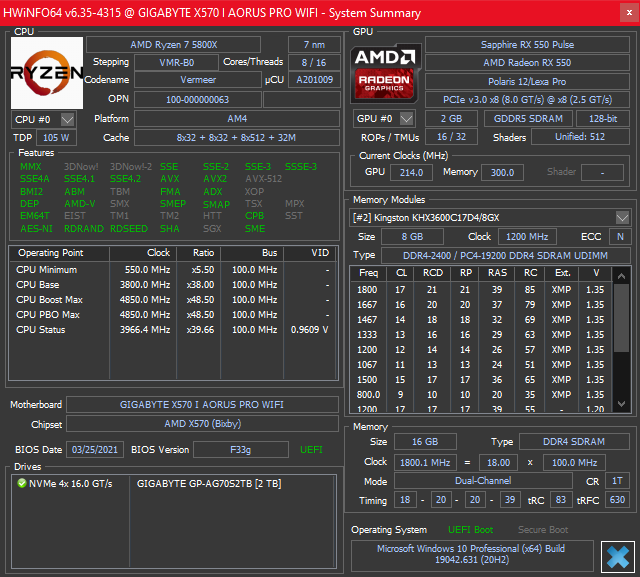
I will present the test set in speed, I tested it on the GIGABYTE X570 I AORUS PRO WIFI motherboard. The Gigabyte AORUS 7000s Gen4 2TB SSD was only partially tested because I don’t have two identical pieces, so I performed write tests against the older Gigabyte AORUS NVMe Gen4 SSD 500GB (for the 205 and 447 GB data write test). The SSD served as the source read disk for other SSDs and will continue to do so.

For the best performance of the tested SSD, I always connect to the main M.2 slot, which is connected to the processor by four fourth-generation PCIe lines. This upper slot has an AMD X570 chipset cooler above it, there is a small fan, which normally only spins around 2000 RPM. To improve the performance of all tested SSDs, I changed its behavior to “Standard”, so that the fan is constantly rotating at some 3500-4400 RPM and blowing the PCIe NVMe disk controller.
The Gigabyte AORUS 7000s 2TB serves as a system drive in the second lower slot of the motherboard, which is connected by four PCIe Gen4 lines to the AMD X570 chipset. During testing, I do not have any devices connected (except the keyboard and mouse) that would take over the connectivity between the chipset and the CPU. I test without network, WiFi and other USB devices. The Sapphire Pulse Radeon RX 550 2GB serves as the graphics card, as I don’t need an extremely fast GPU, and it’s also because the AMD Ryzen 7 5800X processor doesn’t have an integrated graphics core, which could negatively affect performance in some tests. The processor cools the Noctua NH-U12S SE-AM4 heatsink with the Noctua NF-F12 iPPC-2000 fan. The set is powered by the Corsair HX1200 power supply and the primary operating system is Windows 10 Pro v20H2.
I have recently decided to change the testing methodology, mainly in favor of writing tests of large amounts of data. Modern PCIe NVMe disks do not have problems reading sequentially or randomly at high speed, writing is typically problematic. My goal is to exhaust various DRAM caches, SLC caches and so on. There will also be graphics from some common benchmarks and also some quick testers in Linux.
–

